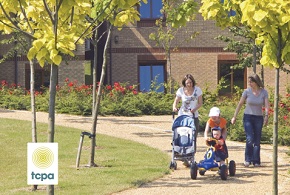Practical guide on health in garden cities
The notion of garden towns/villages has received more momentum in recent years in response to the UK’s housing shortage. As the first garden villages begin to take shape with the government’s support, many are concerned that in creating these new places quantity may be prioritised ahead of quality.
In response to such concerns, and with the support of BRE, the Town and Country Planning Association (TCPA) has produced a suite of guidance with practical steps for creating successful new communities.
This series of Practical Guides provides detail and case studies on a wide range of key issues relating to large developments, including planning, investment, health and wellbeing, delivery, and long-term stewardship.
Guide 8 of this suit was released in December 2017 and 'sets out how new garden cities should be designed to promote the health of their populations. It brings together and supplements the wealth of existing guidance on creating healthy and active environments to inform the planning of new garden cities or new large-scale urban extensions, or the regeneration of existing communities. It builds on each of the garden city principles, but it specifically addresses:
- For health and wellbeing needs, considerations under the ‘beautifully and imaginatively designed homes with gardens, combining the best of town and country to create healthy communities’ principle; and
- For health and care infrastructure needs, considerations under the ‘strong cultural, recreational and shopping facilities in walkable, vibrant, sociable neighbourhoods’ principle.'
The guide addresses the questions of health and wellbeing within the planning and development process when opportunities to increase health and wellbeing across the entire site (and for individual buildings) are far greater and the costs to achieve this are lower. At this stage and scale there are opportunities through economies of scale, site-wide solutions and greater flexibility in design decisions.
Health promoting advice and information within this guide includes both residential and commercial developments and building and comprises of the following core elements of good place-making principles:
- Movement and access.
- Open spaces, play, and recreation.
- The food environment.
- Buildings.
- Neighbourhood spaces and infrastructure.
- The local economy
The Practical Guide further examines each of these elements explaining their relative importance in creating healthy living environments. It then suggests tools and mechanisms for their delivery and implementation which can be adopted by local authorities and delivery partners followed by case studies and success stories.
TCPA refers to BRE’s BREEAM and Home Quality Mark (HQM) as tools that can help implement and measure health and wellbeing elements in design and construction of masterplans and building.
BREEAM Communities and BREEAM New Construction Schemes address the Masterplaning and Design and Construction lifecycle stages of a development respectively. Issues of social sustainability, health and wellbeing and end-user comfort are the most fundamental requirements for assessment and certification within both schemes.
HQM is a national standard for new homes, which helps provide information on a new home’s design, construction quality and running costs. It also shows the impact of the home on the occupant’s health and wellbeing, as buildings become more airtight, respiratory conditions rise and the population gets older. HQM provides consumers with an indication of the quality of living space (indoor air, temperature, light and noise) as well as local amenity.
All this makes creating a high-quality living environment more than just a matter of addressing issues that adversely affect health. Both BREEAM and HQM consider a wider range of contributing factors, such as socio-economics context and local and demographic priorities, to help promote good health in communities. This is a notion recognised within the suite of TCPA Guidance.
For more information and to download the guide, see TCPA.
This article was originally published here by BRE Buzz on 9 Jan 2018. It was written by Rose Pourmatin.
--BRE Buzz
[edit] Find out more
[edit] Related articles on Designing Buildings Wiki
Featured articles and news
RTPI leader to become new CIOB Chief Executive Officer
Dr Victoria Hills MRTPI, FICE to take over after Caroline Gumble’s departure.
Social and affordable housing, a long term plan for delivery
The “Delivering a Decade of Renewal for Social and Affordable Housing” strategy sets out future path.
A change to adoptive architecture
Effects of global weather warming on architectural detailing, material choice and human interaction.
The proposed publicly owned and backed subsidiary of Homes England, to facilitate new homes.
How big is the problem and what can we do to mitigate the effects?
Overheating guidance and tools for building designers
A number of cool guides to help with the heat.
The UK's Modern Industrial Strategy: A 10 year plan
Previous consultation criticism, current key elements and general support with some persisting reservations.
Building Safety Regulator reforms
New roles, new staff and a new fast track service pave the way for a single construction regulator.
Architectural Technologist CPDs and Communications
CIAT CPD… and how you can do it!
Cooling centres and cool spaces
Managing extreme heat in cities by directing the public to places for heat stress relief and water sources.
Winter gardens: A brief history and warm variations
Extending the season with glass in different forms and terms.
Restoring Great Yarmouth's Winter Gardens
Transforming one of the least sustainable constructions imaginable.
Construction Skills Mission Board launch sector drive
Newly formed government and industry collaboration set strategy for recruiting an additional 100,000 construction workers a year.
New Architects Code comes into effect in September 2025
ARB Architects Code of Conduct and Practice available with ongoing consultation regarding guidance.
Welsh Skills Body (Medr) launches ambitious plan
The new skills body brings together funding and regulation of tertiary education and research for the devolved nation.
Paul Gandy FCIOB announced as next CIOB President
Former Tilbury Douglas CEO takes helm.
UK Infrastructure: A 10 Year Strategy. In brief with reactions
With the National Infrastructure and Service Transformation Authority (NISTA).
























